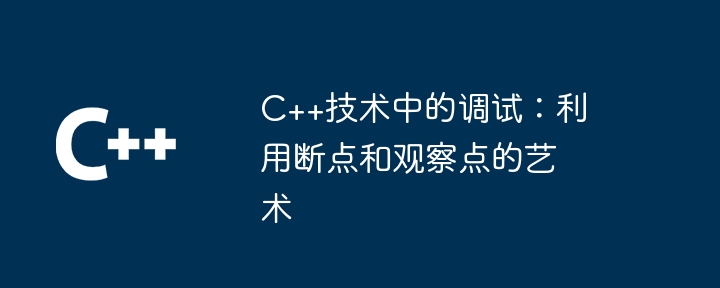
C Debugging tips include using breakpoints and watchpoints. Breakpoints allow execution to be paused at specific locations to examine variable values and code status. Watchpoints continuously monitor a variable or expression and notify the developer when its value changes. This is useful for tracking hard-to-debug values and detecting memory leaks. By careful use of breakpoints and watchpoints, as well as taking advantage of other debugger features, developers can greatly improve their C debugging efficiency.

C debugging skills: make good use of breakpoints and observation points
In C development, debugging is to eliminate program errors and improve Key steps to code efficiency. Breakpoints and watchpoints are two powerful tools that can help developers quickly identify and fix problems.
Breakpoints
Code example:
#include <iostream>
int main() {
int x = 0;
int y = 2;
// 设置一个断点,当 x 等于 1 时暂停执行
if (x == 1) {
// 在此处代码将被暂停
}
x++;
return 0;
}Observation points
Code example:
#include <iostream>
int main() {
int x = 0;
// 创建一个观察点,监视 x 的值
auto observer = [x]() {
std::cout << "x 的值为: " << x << std::endl;
};
observer();
x++;
observer();
return 0;
}Practical case
When debugging a memory leak problem, the observation point is very it works. By continuously monitoring memory allocations, developers can easily track the source of leaks. Additionally, breakpoints can help identify the exact line of code where the leak occurs.
Tips
By taking full advantage of breakpoints and watchpoints, developers can save a lot of time and effort during C debugging and improve the accuracy and efficiency of their code.
The above is the detailed content of Debugging in C++ Technology: The Art of Utilizing Breakpoints and Watchpoints. For more information, please follow other related articles on the PHP Chinese website!
 What are the differences between c++ and c language
What are the differences between c++ and c language
 Recommended learning order for c++ and python
Recommended learning order for c++ and python
 Cost-effectiveness analysis of learning python and c++
Cost-effectiveness analysis of learning python and c++
 Is c language the same as c++?
Is c language the same as c++?
 Which is better to learn first, c language or c++?
Which is better to learn first, c language or c++?
 The difference and connection between c language and c++
The difference and connection between c language and c++
 C++ software Chinese change tutorial
C++ software Chinese change tutorial
 Cost-effectiveness analysis of learning python, java and c++
Cost-effectiveness analysis of learning python, java and c++




